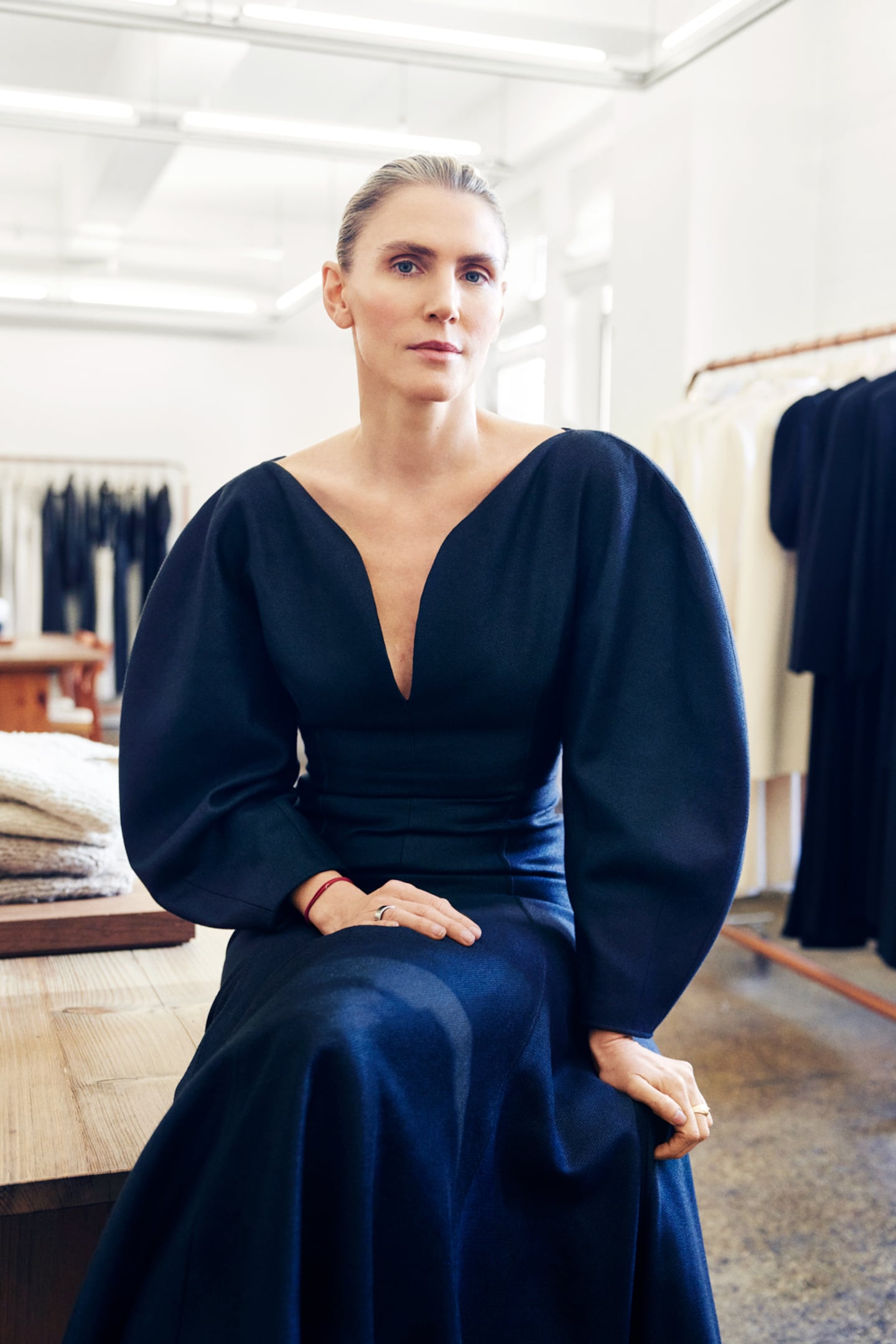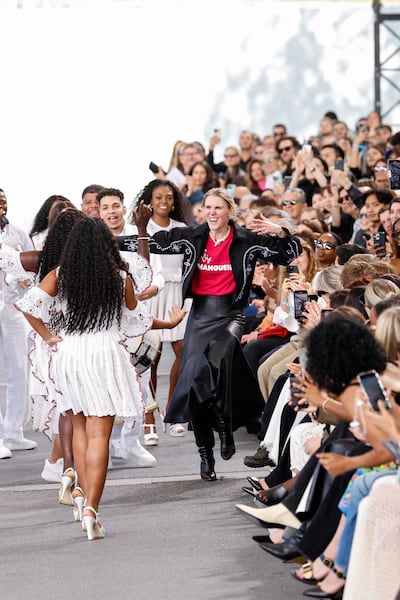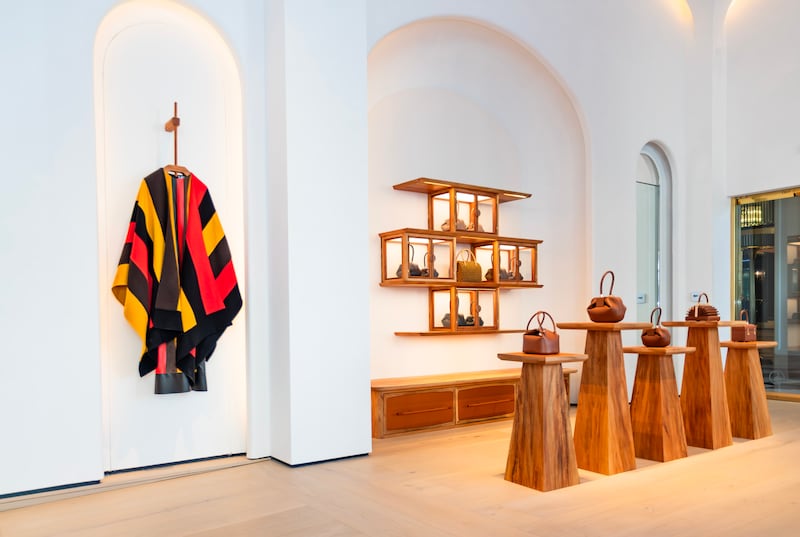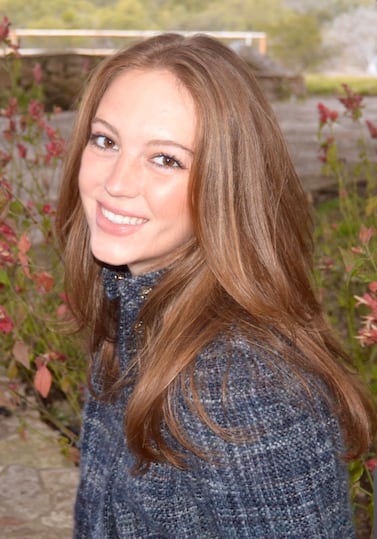
The Business of Fashion
Agenda-setting intelligence, analysis and advice for the global fashion community.

Agenda-setting intelligence, analysis and advice for the global fashion community.

NEW YORK — Gabriela Hearst doesn’t remember learning to ride a horse; it was just a fact of life. Growing up on her family’s ranch near Paysandú in Uruguay, Gabriela — before becoming a Hearst — helped herd cattle with the rest of the gauchos.
When moving cattle, usually one gaucho leads in the front, while another pushes from the back. The rest move around the perimeter, keeping the cows tucked together. It’s all timing, coordination and intuition. Go too fast, and you risk exhausting the cattle. Look away and a calf stumbles off; a sudden movement, and the group gets startled.
Ranch life taught Hearst focus, teamwork and toughness: “Hundreds of heads of cattle, they don’t have feelings if you’re a kid or not. You have to have a command,” she said. “At our pre-shows, it’s calm, nobody is freaking out, everything is done in advance. That’s ranch work ethic.”
Broken down into its simplest elements, the method of moving cattle doesn’t seem altogether different from how Hearst has built her 8-year-old fashion brand: slowly but surely, with one eye on what’s right in front of her, and the other on the ultimate destination. Plus, Hearst says she was dreaming of dresses the whole time she was herding.
ADVERTISEMENT
Now, fresh off an educational three-year tenure at Chloé, the designer is recommitting to her namesake brand.

The designer has set out a three-year plan with chief executive Thierry Colin to build on the foundation she laid when she founded the brand. After opening its third store in Los Angeles in November 2023, the label will open two more retail locations as it aims to double sales over the next three years. The brand is developing its key leather goods and ready-to-wear segments, while expanding footwear and fine jewellery.
The Gabriela Hearst label has attracted heavyweight backers including LVMH, which took a minority stake through its “Ventures” investment unit in 2019, and the designer’s husband, publishing heir Austin Hearst. Still, it’s the designer who will ultimately need to attract new customers with her vision — a challenging task for a small brand.
Hearst says she’s thinking about this long-term: “We will be the luxury brand of the future,” she said. “It’s not going to be in 10 years, it’s going to be in decades.”
Hearst’s close friend, co-founder and collaborator Stephanie de Lavalette has taken to calling her “The Oracle of Paysandú.”
“She’s been saying things that will happen, sometimes shortly after she said them,” said de Lavalette, who also joined Hearst at Chloé as a senior advisor.
Before “sustainability” became a buzzword on every earnings report, Hearst was talking about traceable supply chains, non-virgin materials and decarbonising runway shows. Stealth wealth is booming, and Hearst has always been anti-logo. While many fashion start-ups have struggled to adapt to rising digital marketing costs in recent years, Hearst never paid for it in the first place, sticking with more traditional means of self-promotion.
Humanity can only hope her views on fusion energy — which she designed a collection for Chloé around and thinks could bring Earth back from the brink of climate disaster — will prove as accurate as her other predictions.
ADVERTISEMENT
Even her products, which, from the jump included modern suiting, the bulbous signature “Nina” bag and luxe knitwear, felt prescient. Her aesthetic is at once crafty, authentic and ultra-refined — connecting with both demand for so-called “quiet” luxuries and an admiration for all things DIY that emerged in the pandemic. Hearst is anti-plastic, uses mostly recycled or deadstock fabrics and non-virgin materials which she can pinpoint the origin of, and puts an emphasis on making clothes to last generations. The brand’s merino wool comes from her own ranch.
“She arrived with a finished product. There was not anything ‘emerging’ about Gabriela. She had a point of view from the very beginning, she had good production, good quality and a good fit,” said Julie Gilhart, president of Tomorrow Consulting.
Hearst is known for her meticulous fabric sourcing, tapping niche makers including Manos del Uruguay, a woman-led knitwear collective — and being one of the few proponents of craft and true luxury in American fashion. Her dresses run from around $1,500 to over $15,000.
0 of 9
She’s designing for a particular woman: the brand has dressed Jill Biden, Alexandria Ocasio-Cortez (who drew criticism for wearing a $1,990 Gabriela Hearst blazer in Interview), the Princess of Wales, Meghan, Duchess of Sussex, Laura Dern and Rebecca Hall. Or, grown women fully in their power (spending and otherwise). In certain circles, Hearst has a degree of name recognition herself.
The brand reaches customers with traditional advertising through billboards, magazine placements and ads in select publications like The Paris Review. Most recently, Sienna Miller wore a sweater by the brand on the cover of Vogue’s Winter 2024 issue, shot by Annie Leibovitz.
Retail partners (including Bergdorf Goodman, Net-a-Porter, Elyse Walker and Neiman Marcus) and everyday clients are driving awareness, too: when Gabriela Hearst gets in front of the right shoppers — the kind who also pull The Row, Loro Piana, Chanel and Dior — the product sells itself, according to Bergdorf Goodman’s chief merchandising officer Yumi Shin.
“If you get your customer in a fitting room and give her a few pieces of Gabriela Hearst, they just immediately fall in love with the quality and the fit,” said Shin, who added this year was one of the store’s best years with the brand. “Her reach is definitely getting bigger.”
As the brand scales, Gabriela Hearst wants to get more of those customers into its own fitting rooms, gradually boosting the share of retail sales with a programme of new stores, shop-in-shops and concessions. Its current fleet includes a flagship adjoined to The Carlyle Hotel in Manhattan, a location in London’s Mayfair neighbourhood nested between the Argentinian embassy and Claridge’s, and a newly-opened outpost in Beverly Hills — fit with bespoke furniture, reclaimed sycamore shelves and hand-moulded ceilings.
ADVERTISEMENT

“More and more, we [want to] present the brand moving from the multi-brand wholesale space into a more branded environment,” said CEO Colin. The goal is not to increase the number of places people see the brand, but how they do.
Its stores are minimalist, open and airy, with lightly merchandised racks, white walls, bags on display and no mannequins.
“Skimming all that excess, you think it will leave you with no beauty. On the contrary, it just focuses the beauty and the message,” said Hearst.
The brand exclusively distributes a number of styles, including its most in-demand Nina and Diana handbags to cultivate demand (and boost margins) in its own stores.
Strategic investors — including LVMH — have to be answered to. But they give the brand space to grow at their own pace in a way other backers, like a private equity fund wouldn’t.
“They expect for us to hit some financial results. But, when we discuss our financial trajectory, [LVMH is] always on the side of making the most uncompromising decisions when it comes to making sure we are not cutting corners on the product, the distribution and the marketing,” Colin said.
Hearst’s tenure at Richemont-owned Chloé, a 70-year old, global luxury house, served as a test case for some of the sustainability principles the younger and smaller Gabriela Hearst label is built on. Hearst quickly designed a shoe, the Nama sneaker, which demonstrated that recycled and upcycled materials could be leveraged to make a best-selling luxury item.
“All the research and development we’ve done at Gabriela Hearst — could that be uploaded quickly? … The answer was yes,” said Hearst. “You can build and create better and still get the growth you need, doing a product that is conscious about the realities of this world.”
Chloé swapped in lower impact materials like linen and recycled cotton and cashmere, worked with craftsmen including the Gee’s Bend quilters community in Alabama and became the first major luxury house to achieve B Corp status.
0 of 9
Hearst brought a new perspective to Chloé — formerly home to designers including Stella McCartney, Karl Lagerfeld and Phoebe Philo — and helped to support a strategy around elevating its product offer and reinforcing sustainable, woman-first values. But sources say the designer’s bent toward craft and uncompromising approach to sustainable design pushed prices beyond what customers were willing to pay amid fierce competition from bigger outfits like Dior or Hermès or buzzy, more accessibly-priced labels like Jacquemus.
Hearst and Richemont ultimately parted ways in September, with the latter bringing on a designer from Anthony Vaccarello’s studio at Saint Laurent, Chemena Kamali (who previously worked at Chloé during the business’s peak under Clare Waight Keller).
Still, Hearst is optimistic her impact on the company will stick. “People ask me ‘Do you think Chloé’s going to continue being sustainable?’ Yeah, it’s part of the DNA. We were there like a virus — the right type of virus,” said Hearst.
Hearst made the most of an opportunity that was rare for an American designer — not to mention, a Latin American designer. A renowned Brazilian samba school performed at her last show. Her proudest moment, she says, was putting a Mexican model, Andi Venegas, on a billboard in a poncho on the side of the Louvre.
“I didn’t take a train from London to Paris. I came all the way from the south of the Americas. You have to represent your people,” said Hearst.
At Chloé, Hearst looked under the hood of a full-fledged luxury house. Back at the 8-year-old Gabriela Hearst, she’s connecting the dots. Hearst says she wants to add more structure into her process at Gabriela Hearst.
“At Gabriela Hearst I work directly with the shoe designer. [At Chloé] with teams of people, you become more of an orchestra director … It’s really that dance of the creative process I had to learn to work with, that’s a lot of the training I got at Chloé,” said Hearst.
The brand has laid a solid foundation by keeping things tight. In an era where fashions’ supposed efforts surrounding sustainability are being met with increased scepticism, Gabriela Hearst is known as an earnest advocate for better practices. It has a hyper-prestige positioning [at a time more customers bought in, said Colin]. It has an identifiable, sellable design ethos — and a diverse but edited range of wholesale partners, who carry a limited range of product. Eight years in, the brand is only sold in 90 doors.
“A business of our awareness could have 250, but we don’t believe in over-exposure,” said Hearst. “This is a really tight organism. We don’t grow unnecessarily.”
Scaling up, while risky, is often necessary to support designing, producing and promoting a brand. A slow-and-steady pace is easier said than done. Despite the recent store openings, the brand still depends heavily on department stores and online wholesalers — channels that have struggled in recent years.
Finding the right people to help grow the business, and expanding her product range and distribution network successfully are among the biggest challenges Gabriela Hearst is likely to face, Gilhart said.
“[Hearst will have to] just really get solid on how she can grow and develop her categories more … she’ll have to keep the energy moving and the community growing,” said Gilhart.
In terms of inspirations, the designer hinges her collections on powerful women. For Fall/Winter 2023 it was Eileen Gray, a 20th-century architect overshadowed by her male peers. For Resort 2024 it was the Druids, a matriarchal Celtic clan that thrived at the same time as the Roman Empire. Now, she’s focused on Leonora Carrington, the British-born Mexican surrealist artist known for her paintings and writing about femininity, magic and metaphysical transformation. This season will feature a newly-developed silk jacquard and cashmere lace.
For Hearst, it’s all connected. “I’m following a line … Eileen Gray was Irish. She died on October 31 of 1976 — Halloween is the witches’ Sabbath in the Celtic tradition. All of the sudden I fell into the Druid’s world.” said Hearst. “From the Druids, someone gave me a book about Leonora Carrington … the same magic is there.”
It’s the same for her obsession with fusion energy, which is based on the science that powers the stars, which humans (including herself) have always looked to for answers. (A fan of astrology, she says her sun placement in Scorpio and moon in Aries are compatible, potentially where she gets her self-assuredness.) Like objects in the cosmos, the longevity of a brand is tied to the way it was built, the way it moves.
“Something that comes super fast is going to go super fast,” she said. “Just look at nature.”
At a time when the idea of ‘American luxury’ can feel like an oxymoron, the Uruguayan-American entrepreneur has attracted backing from French luxury group LVMH for her honest vision, marrying beautifully crafted collections with sustainable business practices.
The New York-based Uruguayan designer succeeds Natacha Ramsay-Levi at the Richemont-owned label, bringing a track record of success in handbags and a passion for eco-friendly practises.
Join BoF’s editor-at-large Tim Blanks in conversation with designer Gabriela Hearst on the evolution of Chloé, sustainability and fashion after Covid-19.
The designer’s last show for the Richemont-owned house will be on September 28. No successor has been named.

Joan Kennedy is Editorial Associate at The Business of Fashion. She is based in New York and covers beauty and marketing.
The designer has always been an arch perfectionist, a quality that has been central to his success but which clashes with the demands on creative directors today, writes Imran Amed.
This week, Prada and Miu Miu reported strong sales as LVMH slowed and Kering retreated sharply. In fashion’s so-called “quiet luxury” moment, consumers may care less about whether products have logos and more about what those logos stand for.
The luxury goods maker is seeking pricing harmonisation across the globe, and adjusts prices in different markets to ensure that the company is”fair to all [its] clients everywhere,” CEO Leena Nair said.
Hermes saw Chinese buyers snap up its luxury products as the Kelly bag maker showed its resilience amid a broader slowdown in demand for the sector.